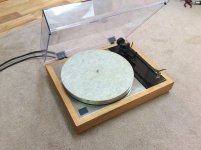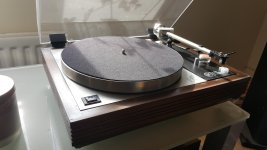Basically it is fairly straightforward.
1. Remove the turntable (both pieces) and the tonearm counterweight.
2. Carefully upend the turntable and remove the base cover.
3. Depending on the PSU that you have, if indeed you have one at all. Remove the PSU and any external connections to the plinth.
4. The plinth is now only held in by the three spring mounts. As you undo each bolt count the number of turns to release each bolt. This will enable you to be pretty close when reassembling the plinth.
1. Remove the turntable (both pieces) and the tonearm counterweight.
2. Carefully upend the turntable and remove the base cover.
3. Depending on the PSU that you have, if indeed you have one at all. Remove the PSU and any external connections to the plinth.
4. The plinth is now only held in by the three spring mounts. As you undo each bolt count the number of turns to release each bolt. This will enable you to be pretty close when reassembling the plinth.
Linn used to say a couple of things. The slight bend on the stainless steel top plate is normal and should not be corrected. All the bolts should be vertical and a tool was used to make them so ( use a tight fitting tube and small spirit level, test in in all directions ). The plinth in a jig with a spirit level used both ways ideally. Also the way the top plate sits on small wood blocks is a Linn choice, like tyres are part of a suspension. The springs are slightly off centre. The longest spring to the motor side, might only be 1mm. The least off centre to the front near the words LINN. Spit is what Linn dealers used as lubricant. Use two hands to rotate the springs to get best bounce, clockwise I guess is best. Do not allow the spring to wind up. If you do the perfect set up is lost overnight. A small gyration of the LP12 can be corrected with the arm wire, try to have none. The old Rega Lustre works very well on the LP12 as long as the arm wire was stripped of it's cotton up to the P Clip. Usually a stiff cable helps a LP12, not so the Lustre. I never had much sucess with RB300 on the LP12.
Matblack....
Have you been able to disassemble your LP12?
I have a very old one, 1973 I think that I have revamped over the years. I traded a Hafler preamp for it in 1990. I fitted a LVX basic arm to it and a V15mkV-mr and enjoyed it for 20 years. Then the diy bug transferred from amps and speakers to the Linn.
I disassembled the whole thing.
Replaced the warped subchassis with a home made aluminum/mdf sanandwich one and replaced the armboard with a flat one, also home made.
Then I built a diy Armageddon for next to nothing since I already had a suitable transformer. This is without doubt the best single improvement.
Last Christmas I was gifted a Corian subchassis and armboard. Another plus.
A few months ago I built a plinth from one piece of red oak, eliminating the stapled top plate support on the three sides.
A few weeks ago, I found out that the dust cover and hinges for the AT-lp5 fits the LP12 plinth exactly, for the princely sum of $50.
I have never heard another LP12, so I am unable to compare mine, but for not a whole lot of money you can turn yours into a giant killer.
Enjoy the journey.
Peter
Have you been able to disassemble your LP12?
I have a very old one, 1973 I think that I have revamped over the years. I traded a Hafler preamp for it in 1990. I fitted a LVX basic arm to it and a V15mkV-mr and enjoyed it for 20 years. Then the diy bug transferred from amps and speakers to the Linn.
I disassembled the whole thing.
Replaced the warped subchassis with a home made aluminum/mdf sanandwich one and replaced the armboard with a flat one, also home made.
Then I built a diy Armageddon for next to nothing since I already had a suitable transformer. This is without doubt the best single improvement.
Last Christmas I was gifted a Corian subchassis and armboard. Another plus.
A few months ago I built a plinth from one piece of red oak, eliminating the stapled top plate support on the three sides.
A few weeks ago, I found out that the dust cover and hinges for the AT-lp5 fits the LP12 plinth exactly, for the princely sum of $50.
I have never heard another LP12, so I am unable to compare mine, but for not a whole lot of money you can turn yours into a giant killer.
Enjoy the journey.
Peter
Attachments
Matblack....
Have you been able to disassemble your LP12?
I have a very old one, 1973 I think that I have revamped over the years. I traded a Hafler preamp for it in 1990. I fitted a LVX basic arm to it and a V15mkV-mr and enjoyed it for 20 years. Then the diy bug transferred from amps and speakers to the Linn.
I disassembled the whole thing.
Replaced the warped subchassis with a home made aluminum/mdf sanandwich one and replaced the armboard with a flat one, also home made.
Then I built a diy Armageddon for next to nothing since I already had a suitable transformer. This is without doubt the best single improvement.
Last Christmas I was gifted a Corian subchassis and armboard. Another plus.
A few months ago I built a plinth from one piece of red oak, eliminating the stapled top plate support on the three sides.
A few weeks ago, I found out that the dust cover and hinges for the AT-lp5 fits the LP12 plinth exactly, for the princely sum of $50.
I have never heard another LP12, so I am unable to compare mine, but for not a whole lot of money you can turn yours into a giant killer.
Enjoy the journey.
Peter
Have you been able to disassemble your LP12?
I have a very old one, 1973 I think that I have revamped over the years. I traded a Hafler preamp for it in 1990. I fitted a LVX basic arm to it and a V15mkV-mr and enjoyed it for 20 years. Then the diy bug transferred from amps and speakers to the Linn.
I disassembled the whole thing.
Replaced the warped subchassis with a home made aluminum/mdf sanandwich one and replaced the armboard with a flat one, also home made.
Then I built a diy Armageddon for next to nothing since I already had a suitable transformer. This is without doubt the best single improvement.
Last Christmas I was gifted a Corian subchassis and armboard. Another plus.
A few months ago I built a plinth from one piece of red oak, eliminating the stapled top plate support on the three sides.
A few weeks ago, I found out that the dust cover and hinges for the AT-lp5 fits the LP12 plinth exactly, for the princely sum of $50.
I have never heard another LP12, so I am unable to compare mine, but for not a whole lot of money you can turn yours into a giant killer.
Enjoy the journey.
Peter
If you take a hammer to the old sub chassis and use a window to cheek flatness it will greatly help set up. I have always thought 5 ply would do a good job.
I upgraded out of need the Valhalla. 220 uF 250V replace 47 uF that failed commending with poor starting. For simplicity of description replace all three. This takes hum modulation down to -54 dB from - 41 dB when mine. - 60 dB if the Valhalla is floated on a 1:1 transformer or 230 V to 115 V isolation type. Read up on floating supplies before using.
I upgraded out of need the Valhalla. 220 uF 250V replace 47 uF that failed commending with poor starting. For simplicity of description replace all three. This takes hum modulation down to -54 dB from - 41 dB when mine. - 60 dB if the Valhalla is floated on a 1:1 transformer or 230 V to 115 V isolation type. Read up on floating supplies before using.
I think there was a time when LP12's lost the bend. I have a feeling my 1989 version is flat. Linn dealers were told to retain the shape. Bolts when zinc plated seldom were straight. They need to be vertical. The nuts were changed 4 times at least to stop the spring wobbling when the nut rotated. This can make the larger difference I ever heard with LP12's related to cost. Belts seem to last forever unlike Thorens. The motor screws set the belt tilt for speed and running true. Invert platter to see it in action.
Mine had been in the loft for about 30 years. I refinished the plinth and replaced the oil and belt and it was as good as new. Since then it's had a new VP top plate a Cirkus bearing and a Valhalla PSU. The arm had been sold so I had to buy an Ittok II and I fitted a Linn Arkiv MC cartridge.
I was the Linn specialist at my shop and repair man. I visited the factory when very young without invitation and had a very special tour. My proudest moment was when a student brought an LP12 to me that was badly abused. He had zero money so I built him a mostly new turntable out of all my too good to throw away secondhand parts. It was a 100% as an early serial number LP12 should be. I was caught hammering the sub chassis by the Linn rep who was none too pleased. He didn't understand the concept of doing it for nothing because the lad had been ripped off. The thing I gave him was a perfect hub and bearing of a type that had been upgraded, The sound was magical and in some ways better than later types. Certainly a bit fruity in the bass. Very easy to love. I never really asked the lad how he got on with it. It just was a way of using up the parts. My boss didn't mind as it was done when nothing much going on. I have a hunch it was better than the factory version as the chassis was as flat as our plate glass window,
I have an LP12 and Garrard 401. In many ways alike. The 401 is more rock solid in image location and has really deep bass. Otherwise two peas in a pod.
I have an LP12 and Garrard 401. In many ways alike. The 401 is more rock solid in image location and has really deep bass. Otherwise two peas in a pod.
- Status
- This old topic is closed. If you want to reopen this topic, contact a moderator using the "Report Post" button.
- Home
- Source & Line
- Analogue Source
- Linn Disassembly / Plinth removal

